
Svea class coast defence ships (1886)
 Swedish Navy – Svea, Göta, Thule
Swedish Navy – Svea, Göta, Thule
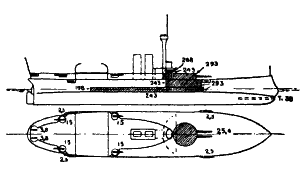 The Svea class armored ships (“pansarskepp”) of the Swedish fleet comprised HMS Svea, Göta and Thule. They were coastal defensive ships armed with 25 cm guns and the lead vessel was launched on 12 December 1885. They were modernized in 1900-1904, and after enforcing the country’s neutrality in WWI, were discarded betwen 1928 and 1941, making fairly long careers. https://bit.ly/3BTDIcn #pansarkepp #pansarbåt #swedishnavy #svenskamarinen #WW1
The Svea class armored ships (“pansarskepp”) of the Swedish fleet comprised HMS Svea, Göta and Thule. They were coastal defensive ships armed with 25 cm guns and the lead vessel was launched on 12 December 1885. They were modernized in 1900-1904, and after enforcing the country’s neutrality in WWI, were discarded betwen 1928 and 1941, making fairly long careers. https://bit.ly/3BTDIcn #pansarkepp #pansarbåt #swedishnavy #svenskamarinen #WW1
Design Development
Around 1850, Swedish’s defensive strategic thinking was dominated by the “central defense principle”. The doctrine pointed that in the event of an invasion delayed by the Navy, the army should retreat inland to Karlsborg’s fortress as a fixation point for it to be destroyed by reinforcements. The Swedish Naval Forces had to refrain from engaging the enemy fleet out at sea and instead, function as an inlet defense with the main task of defending the archipelago and inlets to Swedish most important coastal cities.
Early in the 1870s, however, opinion was voiced about the Swedish fleet in need to be able to meet the enemy on the open sea if need be. By this time, Great Powers, even outside France and Britain, like the neighbouring Russia or Prussia, introduced large ocean-going ironclads with heavy artillery that can out-range Swedish vessels with ease. At the 1875 Riksdag session, the naval minister Fredrik Wilhelm von Otter, proposed that the Swedish fleet should be supplied with ironclads too, but was refused.
The 1870s arms race
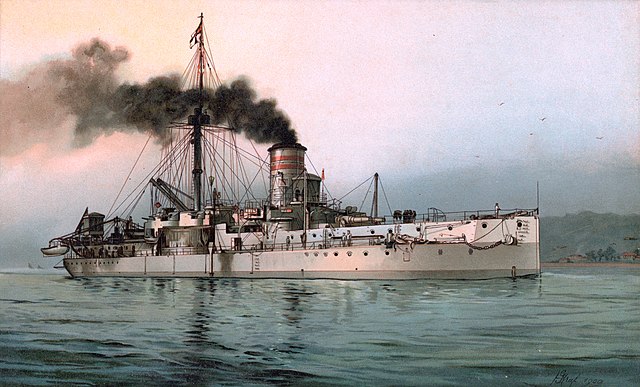
The German battleship SMS Württemberg, launched 1878. Lithograph by Hugo Graf, 1902.
Still the future of the fleet was discussed eagerly in Sweden, as everyone can see an arms race developing in the Baltic Sea area between Russia and the newly formed German Empire. Neihbouring Herman Empire now boasted a fleet of no less than nine large armored ships. And Sweden was fully aware of sabre-rattling about borders, like during the Second Schleswig War. From 1877, the Kaiserliches Marine would go up in tonnage and armament. The Russian Navy meanwhile experienced the strongest expansion of its historoies, with views on the Pacific, and constant reinforcement of the Baltic fleet, for long second to the Black sea fleet. And with the influence of the French Young School, produced itself in the 1880s decade a fleet of a hundred torpedo boats which could be transported by rail at any moment to the Östersjön. An if diplomatic tensions with Russia were toned down, the souvenir of the epic XVIIIth cent. wars and rivalry with Russia was still in all memories.
The Maritime Defense Committee 1880
 Soon, increasing political tensions were taken at last in account by the Swedish government, which in 1879 appointed a committee to find out the best expansion scheme for the fleet. The committee pointed out that existing monitor-type vessels in service until then no longer fit requirements of the time. Their guns were short range and their seakeeping abilities were fairly limited, even in moderate weather. They also lacked speed and maneuverability and in general, just cannot compete with a modern battleship. The committee retook von Otter’s opinion about the need of sea-going, heavily armed armored ships to meet any enemy beyond the coastline. For more precision, these vessels were the three John Ericsson class (1865-67 Thordon, Tirfing) and the 1870, 1574 tons HMS Loke.
Soon, increasing political tensions were taken at last in account by the Swedish government, which in 1879 appointed a committee to find out the best expansion scheme for the fleet. The committee pointed out that existing monitor-type vessels in service until then no longer fit requirements of the time. Their guns were short range and their seakeeping abilities were fairly limited, even in moderate weather. They also lacked speed and maneuverability and in general, just cannot compete with a modern battleship. The committee retook von Otter’s opinion about the need of sea-going, heavily armed armored ships to meet any enemy beyond the coastline. For more precision, these vessels were the three John Ericsson class (1865-67 Thordon, Tirfing) and the 1870, 1574 tons HMS Loke.
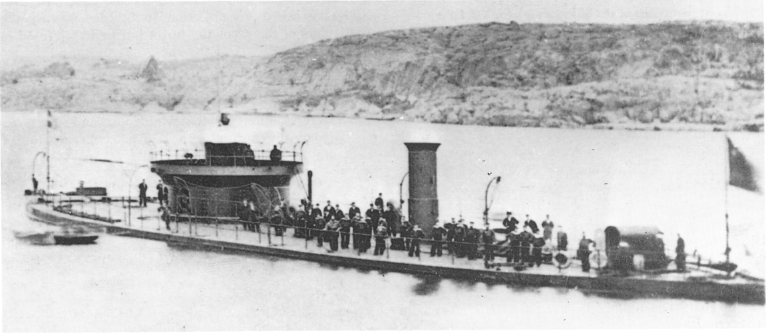
The previous Monitor HMS Ericsson (1867), which differed little from those of the American Civil war. Hardy an off-shore defensive deterrent.
Early sketches and concept drawings were elaborated for this new type A or “Pansarbåt typ A”, carried out by Marinförvaltningens ingenjörsavdelning Göthe Wilhelm Svenson. It was essentially a development of the Loke design, mixed with the armored gunboats of the 1860s with a well-increased freeboard for greater seaworthiness. The overall lenght was designed to be 68 meters long for a displacement of 2,622 tonnes. Armament was soon fixed on two 25 cm guns (10 in) and three 15 cm guns (6 in).
A new government took office in 1881 and Carl Gustaf von Otter was appointed as the new Navy Minister. A new maritime defense committee was also created, which worked for a year based on the previous design, which took into account calculations about Russia’s and Germany’s troop transports in potential invasion scenarios. The Russians were suspected to be able to deploy to Östersjön a transport fleet of some 103 vessels escorted by 14 large armoured ships, an invasion force of over 36,000 men, 10,000 horses and 1,500 field guns. The German capacity was estimated on this even greater, with 360 ships escorted by 19 armored ships, carrying 100,000 men, 30,000 horses, 5,000 guns. These frightening possibilities conducted some in the committee to see bigger.
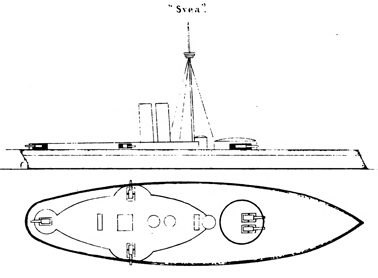 Still, the majority thought the A-type was best suited for the task of deterrence. Acquisition of three Type A was recommended and the Riskdag at last voted funds to be allocated for first of these Pansarkepp in 1883, but by the first chamber. The second chamber of the Riskdag refused. A political battle followed until a joint vote was obtained, to have the proposal approved. HMS Svea was eventually ordered to Lindholmens varv (NyD) on 14 January 1884. She was laid down in March that year, launched on 12 december 1885 and completed on 20 september 1886. In 1887 and 1890, the Riksdag also allocated funds for the two others, named Göta and Thule, built this time in Finnboda varv for the latter. They differed from the lead ship in some aspects but all three are still considered sister ships by the majority of historians, and that’s the position taken here.
Still, the majority thought the A-type was best suited for the task of deterrence. Acquisition of three Type A was recommended and the Riskdag at last voted funds to be allocated for first of these Pansarkepp in 1883, but by the first chamber. The second chamber of the Riskdag refused. A political battle followed until a joint vote was obtained, to have the proposal approved. HMS Svea was eventually ordered to Lindholmens varv (NyD) on 14 January 1884. She was laid down in March that year, launched on 12 december 1885 and completed on 20 september 1886. In 1887 and 1890, the Riksdag also allocated funds for the two others, named Göta and Thule, built this time in Finnboda varv for the latter. They differed from the lead ship in some aspects but all three are still considered sister ships by the majority of historians, and that’s the position taken here.
Design of the Svea class
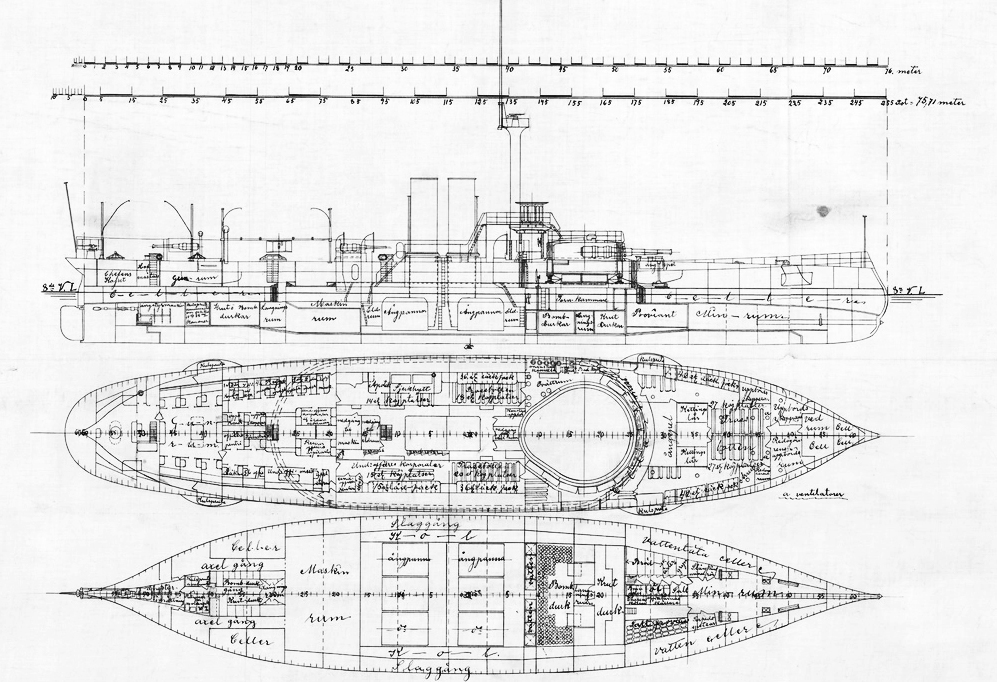
Hull Construction and general design
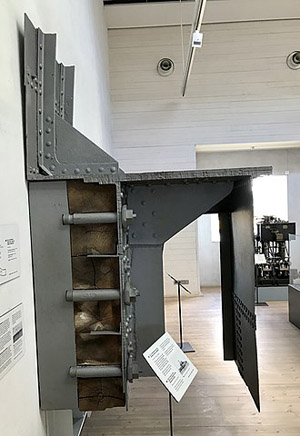 Svea’s hull had a significantly higher freeboard than earlier Swedish vessels. Heavy artillery was also placed almost twice as high above water and had a much better range. The hull was entirely constructed in Motala bessemer steel, 75.7 meters long (waterline), for 14.84 meters wide and with a 5.18 meters draft. Length/width ratio was 5.1. to compare with 1865 John Ericsson, 4.5. They were made for better speeds. Göta and Thule were even slightly longer at 78 meters overall, and greater draft.
Svea’s hull had a significantly higher freeboard than earlier Swedish vessels. Heavy artillery was also placed almost twice as high above water and had a much better range. The hull was entirely constructed in Motala bessemer steel, 75.7 meters long (waterline), for 14.84 meters wide and with a 5.18 meters draft. Length/width ratio was 5.1. to compare with 1865 John Ericsson, 4.5. They were made for better speeds. Göta and Thule were even slightly longer at 78 meters overall, and greater draft.
To increase seaworthiness, the stern was provided with a so-called brädgång (“upright plating hatches”) which could be lowered when the artillery needed a better arc of fire and depression. If the weather was bad enough, these were normally raised up to provide the hull better elevation. Their hulls were also divided into many watertight compartments, separated by longitudinal and transverse bulkheads, no less than 194 on HMS Svea and 199 on her two sisters. There was also a layer of cells filled with cork below the waterline, in the hope of increase their buoyancy in case of flooding. The compartimentation, funnily enough, was less thought for torpedo damage but collision at sea.

Engraving of HMS Svea in the 1880s.
Overall their design was reminiscent of battleships by the lenght-width ratio indeed, and as shown in the basic schemes, it was minimalistic, with a large place made to the main twin turret, and the small bridge and conning tower behind, followed by a battery superstructure going up to the broadside after the usual recess to grant the best rear fire arc to the main turret. There was a single, thick military mast supporting the spotting top and two light QF guns. Right behind were located the two main funnels, of equal size and with flattened sides (round on Thule). The three secondary aft guns were located in a triangle pattern, later during modernization, in four positions. The stern was a very classic clipper style, also very popular on liners and most merchant vessels of the time. The bow so-called of the “swan” type was a faux ram, with a torpedo tube below.
Service boats were located around the funnels and aft on the battery deck’s roof. The crew varied over time, at first comprising 237 officers and men. It was not much lower as a submarine tender for HMS Svea at the end of her career, but she add a much lesser armament and additional facilities and structure (see later). These ships were well and strongly built, and endured the test of time, since they were still around up to the end of the interwar, transformed as much as possible to fit their new roles.
Armor protection
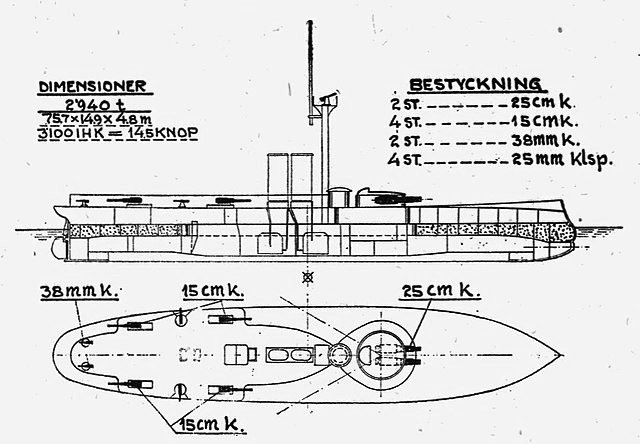
Drawing över Svea showing the thickness of the armor in mm and the caliber of the guns in cm.
The Svea-class armored ship were protected by Schneider & Co steel, made in Le Creusot, France. The armor protection took inspiration from famous ironclads of the time such as the HMS Inflexible and the Italian Caio Dulio. Here are the details:
Armor belt 293 mm () thick over 35 meters (). Intermediate Layer of teak wood with the deck.
Transverse bulkheads Unknown.
The Citadel around the vitals parts (engine rooms, ammunition bins) was short and had rounded ends.
The armored deck 49 mm () thick stretched fore and aft around the waterline belt, formed the rounded turtle-like structure over the citadel.
ASW protection counted on heavy compartimentation, most being coal boxes around the the engine area, as long as filled.
Conning tower: 268 mm or 10-1/2 inches
Krupp steel was used for the guns turrets and their barbettes.
Main Gun turret: 268-290 mm armor (10.5-11.4 in), later 7.-1/2 inches
Main turret hoist and barbette 5-in (127 mm) – After refit.
Aft secondary turret 268 mm (10.5 in), later 5-in.
Aft secondary turret’s barbette and ammo hoist 100 mm (4 in) – After refit.
Machinery
The Svea class had two propeller shafts while the steam engine was manufactured at the Motala Workshop, Göta canal. They had six cylindrical steam boilers with double-ended drums in a single machine room, which supplied steam at 5 kg/cm² working pressure to two two-cylinder compound machines, which developed a combined power of 3,100 indicated horsepower at 105 revolutions per minute.
Design speed was 14 knots, with 14.7 knots sustained on trials. Operational radius extended to 2,240 nautical miles at 10 knots cruise speed. Fuel consumption was good, with one coal kg per horse power and hour. They were considered good steamers. However the machinery was quite heavy, the equivalent of 100+ kg per horse power. It took also 73 m² of space per 1,000 horsepower. They were protected under the armored deck and due due to the limited width placed in “double weight”, with the crankshaft closest to the cylinder bottom. Each piston as a result had two rods attached outside the top center working on either side of the crankshaft. The condensers were housed under the machines. Nominal capacity for coal was 260 tonnes but it could be augmented to 288 tonnes if needed.
Göta and Thule on this also differed from the lead ship: Steam pressure was augmented up to 6.25 kg/cm² for 4,600 ihp, and 16 knots (more on trials). The radius of action also went up to 2,400 nautical miles with a coal capacity raised to 290 tonnes.
Armament
The admiralty planned all three to be supplied Svea with Swedish-made artillery, but the local industry was just not was capable at that time to deliver such massive guns. After a search, the choice fell on famous manufacturer Armstrong Withworth, Elswick, well used to this manufacturing, and took charge of the entire order of six main guns and twelve spares at a cost of 19,000 crowns. Secondary guns also came from Armstrong. In addition to the seocndary and QF anti-TB cannons, the Svea class also had, not uncommon in that time and age, “boarding” weapons, in the shape of four 2,54 cm heavy machine-guns (see later). It is not known if they were dismountable for landing parties.
Main Artillery
The main battery consisted of two breech-loading 25.4 cm guns m/1885 (10 inches), mounted in a rotatable tower (meaning a platform not connected to the fixed ammo well). This platform was surmounted by a semi-open cupola and rested in a sort of low-rise saddle, which could move forward and back on two underlying cursor beams. There was a hydraulic recoil brake and elevation was powered by a steam engine-driven liquid pump. Traverse used a gear wheel and ring gear sitting under the turret table. This allowed a good arc of fire of 136° on either side, to 272° total on 360 theoretical.
These heavy guns fired a 200 kg (440 Ibs) HE or AP shell at a rythm of one shot every five minutes, up to 8,500 m max (9,300 yds). However useful range went down to 2,000 metres (2,170 yds), and an AP shell at this distance was estimated capable of defeating any armored ship in the Baltic. Göta and Thule were armed the same, but produced over time, their gune were noted as the m/1889A and m/1889B with improvements such as a more advanced breechloading mechanism under 60 seconds, for a far better rate of fire of around a shot every 2 minutes.
Secondary artillery
The secondary armament of the Svea class consisted of four 15.2 cm guns (6 in) m/1883 and m/1889 för Göta and Thule. Two were mounted on each broadside, encased behind 25.4 mm (10 in) thick shields in the open superstructure. Svea’s went from Armstrong but Göta and Thule had those manufactured by Bofors, at the time a landmark for the Swedish company.
Anti-torpedo boat Cannons
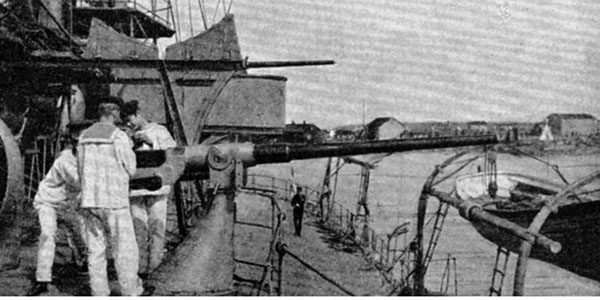
Against the rising threat of torpedo boats, HMS Svea and her sister ships had small, fast-firing guns and machine guns. Two fast-firing 38 mm guns m/1884 were mounted on the aft edge of the superstructure. They were supplemented by four four-barreled 25 mm machine guns m/1877 in drum-like projecting semi-circular platforms in the hull on each side of the ship. A single 10-barrel machine m/1875 was placed on the military mast’s spotting top. Machine guns as said were also a boarding defence scheme, still considered a real possibility in the 1880s.
Torpedo Tubes (and ram)
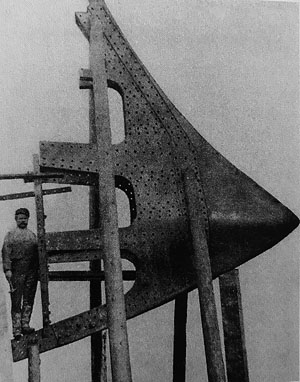 Svea and Göta also had torpedo tubes in the foredeck, but Thule had a ram bow, without torpedo tube. The ram use was “discovered” at the Battle of Lissa between Austria and Italy and estimated to be a valuable last resort weapon by the Swedish Admiralty, which pressed designers to install it on this particular ship. It was also planned to provide Svea and Göta with a ram also originally, but as the bow torpedo tubes were sensitive to impacts and constituted a hull weakness the prospect was abandoned abandoned. Instead they were fitted with “swan bows” but retained their torpeod tube.
Svea and Göta also had torpedo tubes in the foredeck, but Thule had a ram bow, without torpedo tube. The ram use was “discovered” at the Battle of Lissa between Austria and Italy and estimated to be a valuable last resort weapon by the Swedish Admiralty, which pressed designers to install it on this particular ship. It was also planned to provide Svea and Göta with a ram also originally, but as the bow torpedo tubes were sensitive to impacts and constituted a hull weakness the prospect was abandoned abandoned. Instead they were fitted with “swan bows” but retained their torpeod tube.
Svea ha a 38.1 cm underwater bow torpedo tube, with the torpedo room located at the bottom of the stem, under the armored deck, with six torpedoes m/1889 in reserve. Göta, had two overwater tubes located amidships on the weather deck. These tubes were stored in ball-shaped sealing sleeves and had travers. HMMS Thule’ framing however and ram prevented the installation of hull tubes and had instead two 45.7 cm (18 in) broadside deck tubes with some traverse, 40° forward and 20° aft.
Modernizations

Jane’s 1914 edition on the modernized Svea class
It was done in several steps. Mostly driven by Artillery, as its development went for accuracy and fast-firing capabilities.
-In 1896–97 her secondary artillery was exhanged for fast-firing 12 cm guns m/1894.
-The two 57 mm QF were replaced with six m/1894B, by Bofors.
The second wave was in 1900, fuelled by lessons learned from the 1894 Sino-Japanese War, 1898 Spanish-American War. It was argued that the main artillery was too exposed in the same unique turret. The admiralty wanted it spread out, with a lesser caliber, but faster and longer range single 21 cm cannon m/1898. Hitting power was still equivalent thanks to new ammunitions.
If two were planned in smaller turrets, forward and aft, the increase in weight conducted to its abandonment and instead a single gun was kept forward but completed by no less than seven 6-in (15.2 cm) m/1898 artillery pieced in single mounts, three on either side, one on the aft deck. This was complemented by the new quick-firing 57 mm m/1898B in the superstructure, protected by 6.4 mm armored shields. Göta and Thule got rid of their main deck torpedo tubes as space was lacking.
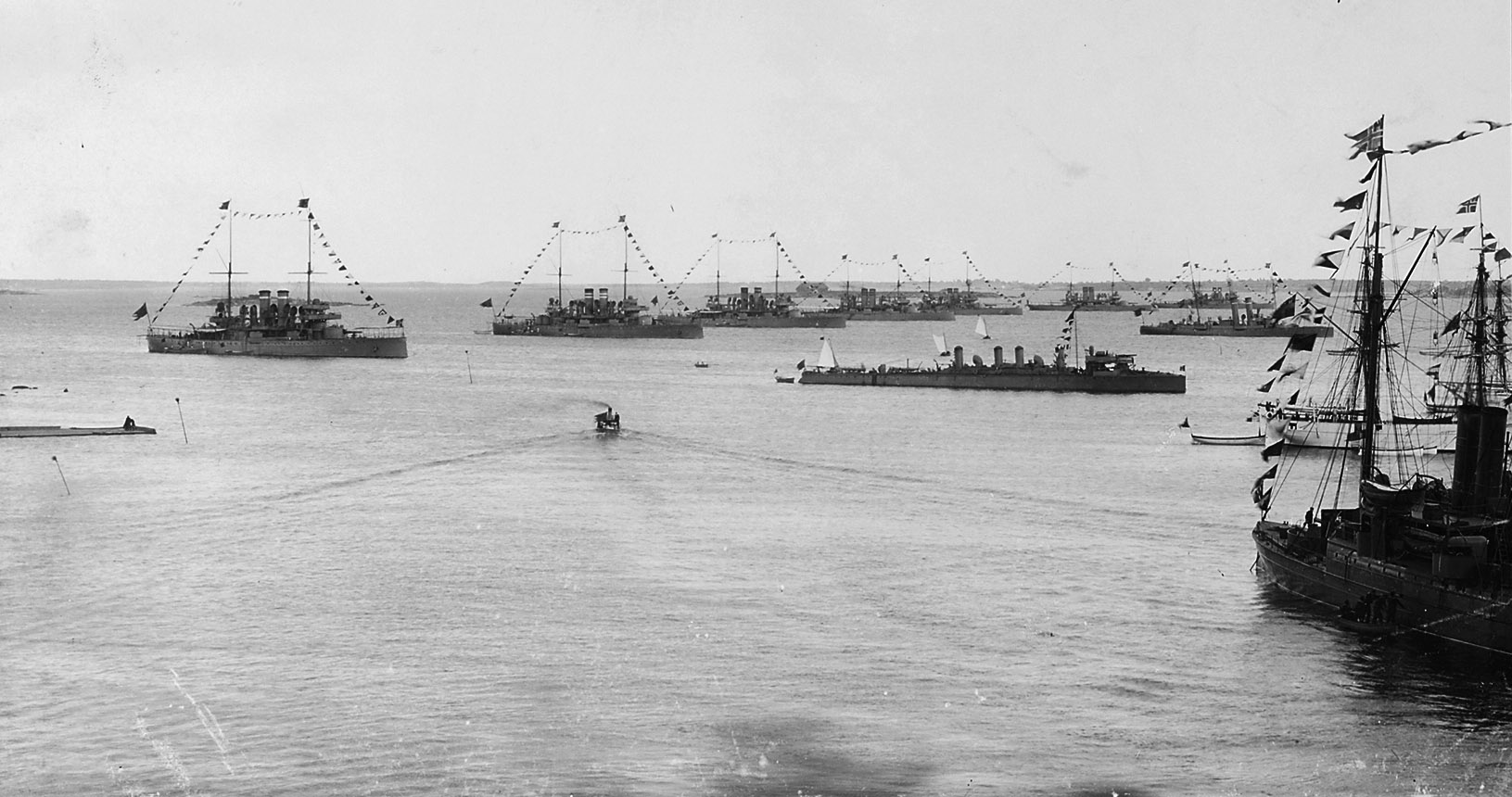
All three ships anchored with the fleet at Karskrona for a review on 9 July 1904, freshly rebuilt.
Improvements were made also to the armour, with new processes allowing to reduce thickness but providing the same degree of protection. The main gun turret (still on a platform, not barbette) saw a new flat-side rounded turret with 19 cm walls (7.4 in). The 15 cm cannons had semi-turrets with 11.5 cm (4.5 in) walls. During the same rebuilding, The heavy military mast was removed and twio light pole masts fitted instead, the foremast supporting a lookout and signal platform and the aft rigged mast supporting the wireless telegraphy apparatus. The Svea class’s old wooden deck was replaced by an insulated iron deck while interior wooden furniture were removed as a fire hazard, ventilation improved, portholes plated over, electric lighting modernized and electric power augmented.
This major reconstruction was perfomed at Karlskrona örlogsvarv, Göta being the modernization prototype, starting on 1 July 1900, completed in December 1901. However it proved more complicated than expected, even through the machinery was mostly unchanged. Thule had to wait 1.5 years for her turn and Svea was last, and more extensive than the others, as her main turret had to be moved deeper into the hull. This ensured they would serve for another 20 years, depending on the elderly machinery’s maintenance.
Career
 HMS Svea
HMS Svea
HMS Svea was launched on 12 December 1885 at Motala Mekaniska Verkstad, a subsidiary in Gothenburg, and commissioned on 20 September 1886, about a year later. Construction costs without equipment and furniture rose to 1,134,000 crows. Until 1921 she served in her initial role, but was was converted into a staff and submarine depot ship, the only way for her to survived into WW2.
Despite she was the lead ship, the launch ceremony was very simple, unattended by King Oscar II due to severe winter conditions. On September 20, 1886 the navy arrived in Gothenburg aboard the gunboat Skagul and five days later, both departed for Karlskrona and her outfitting. She was a radical improvement of the Swedish fleet at the time, modern and very capable, including as planned, to defeat any threat on the open sea. She was of course gradually modernized to stay relevant during her early years of service. In 1890, the addition of four 12-pdr w/1889 guns, 1896-97, 12 cm guns m/1894 installed, by six 57 mm guns w/1889B installed, and finally the 1903-04 reconstruction.
The 1897 modernization was put forward by her royal majesty Oskar II, which had deep interest for the fleet, and requested additional funds to have the whole class maintained in modern conditions to stay relevant as a deterrent. During the 1901-1904 reconstruction, Karlskrona Artillery Corps Colonel Anders Fredrik Centervall also requested the modernization of the military base’s fortress artillery, but only obtained a compromise as the coastal fortress earned the replaced main and secondary guns of the Svea class, notabvly the entire two turret, complete with their turret.
After being rebuilt, HMS Svea was transferred from the coastal fleet, later “coastal squadron” and made in full battle readiness after the dissolution of the union in 1905. With the rise of international tensions, this would stay the same until the first World War, but at that stage, and despite extensive modernization, military technology outpaced the Svea class. Much better vessels, larger were completed in between, including the Sverige class, which made the 1st generation Svea completely obsolete on paper. In 1915, the admiralty considered them no longer as relevant combat assets.
The same year, HMS Svea was retrogaded as a barracks ship. Two 15.2 cm guns were removed. In 1918, it was decided to convert her into a depot submarine ship. The main gun and remaining secondaries were removed, a large deckhouse erected extening from the leading edge of the bridge to the stern. This was all done in Karlskrona in 1921. Se made speed trials, was re-accepted into service, but anchored from most of the time, her old machinery did no mattered much. In 1932 her remaining 12 cm guns were also removed and the only defensive armament consisted from then on in two 40 mm Vickers m/1922 AA “pompom” guns.
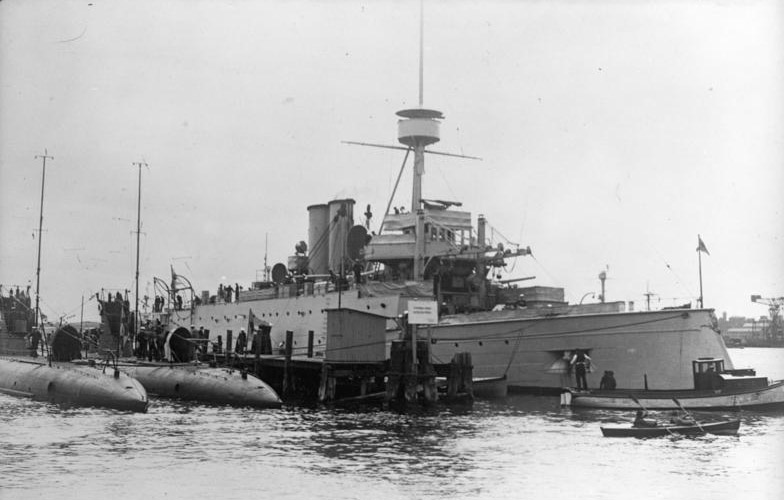
Later, her machinery was halved, with two boilers and the corresponding funnel removed, making room for additional storage. In 1939 as the war broke out, an assessment was made. It was concluded her general state was still good although her hull was quite aged at this point, but her machinery was so old and in such condition it was decided not to risk using it, and she was from then on only towed to position. As a new generation of modern ships were planned it was decided in 1941 to have her decommissioned.

Svea as a sub-tender in the interwar
She was later stricken, put on the sales list, and sold to Karlskrona shipyard for scrapping in 1943-44. So she did not saw the end of the war, but was still in service in 1939 despite her age. She saw all conflicts basically since 1894 at that stage, making her the oldest serviced warship ever in the Swedish inventory.
 HMS Göta
HMS Göta

Construction of Göta in 1889.
HMS Göta as commissioned on 1 July 1891, making her acceptance sea trials on April 22, 1891, reaching 14.9 knots on average, and judged not completely satisfactory. A renewed test was performed four days later after some fixes. This explained the delay until July, 1. In 1891-96, she became was the flagship of the coastal fleet, later coastal squadron but the staff complained of cramped and unsufficient accomodation in that role. On 23 May 1894 was ordered modifications for her new role of flagship.
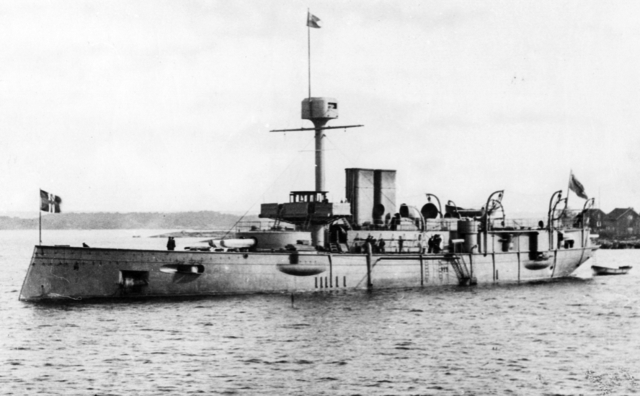
In 1895 Germany opened the Kaiser-Wilhelm-Kanal (Kiel Canal) in Schleswig-Holstein allowing the transit of her fleet from the Baltic Sea to the North Sea. The ceremony was attended by 14 nations including Sweden, which sent Göta and Thule under command of Vice Admiral Fredrik Wilhelm von Otter, escorted by the gunboat Edda. On June 16, they arrived in Kiel Bay and honored at Friedrichsort the German flag by with 21 shots as well as Prince Henry of Prussia aboard SMS Wörth. Moored at designated buoys they were visited on 20 June by the Kaiser from his yacht Hohenzollern, on his way to Brunnsbüttel. They fired a 31-shot salute and crews were invited ashore to balls and fireworks in Kiel, before departing for Karlskrona the following day.
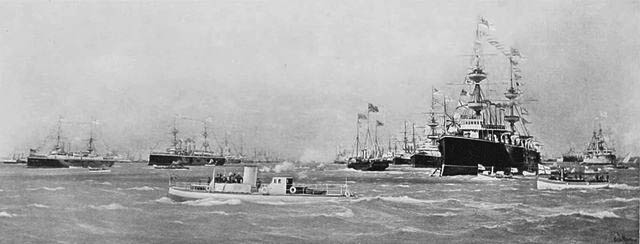
The Spithead review
Queen Victoria celebrated her 60th anniversary in 1897 and the naval review in Spithead, off Portsmouth saw Sweden invited, sending HMS Göta Commandeded by Magnus Ingelman and second captain Herman af Sillén, also carrying Rear Admiral Hjalmar af Klintberg as representative of the king. She also saied with 52 conscripts and went through the Kiel Canal, but was later battered by North Sea heavy weather. Göta had to come back and took refuge outside Brunnsbüttel until the 17th. Damage was assessed, as she was flooded with about 23 tonnes of seawater. The machinery worked well however. As the weather improved she proceeded in the English Channel on the 18th, and upon arrival, Admiral af Klintberg and other senior officers left for London. On June 22 she made a 60 shots salute. On June 26 she hoisted the very large parade flag to salute the Prince of Wales aboard the Yacht Victoria and Albert. Göta returned to Karlskrona on 4 July 1897.
As her sisters, she was completely modernized, and by 1904, was ready for another decade of service. She was transferred to the local forces and retook her place as flagship of the Gothenburg squadron in 1915, then Stockholm squadron in 1917. After the war was over, the admiralty considered her obsolete and suggested a decommission as in a fronline role on 12 October 1923.
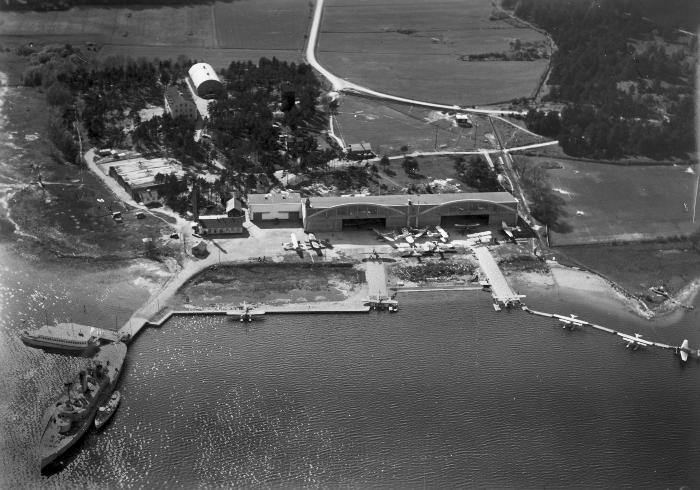
Göta as an accommodation ship at Roslagen’s air fleet (F2) in Hägersnäs.
But after being examined carfully, it was estimated her hull was still in pretty good shape, if her machinery was not. Not scrapped, it was decided to convert her as an accommodation ship in 1927. She was to be a parmament mobile base for the newly created Swedish Naval Air Force (Svenska Marinen flygvapnet). Her main armament was removed, replaced by 40 mm Bofors guns, and new accomodation built. Recommissioned, she was sent at Roslagen’s air flotilla (F2) in Hägersnäs to replace the very old steam corvette HMS Freja. In 1938, she was decommissioned again to free crews for more modern ships and owing her weak value. She was mothballed and finally scrapped at Stockholm 1942-43, with the remains sold and reused as a tipping pontoon in Riddarfjärden.
 HMS Thule
HMS Thule
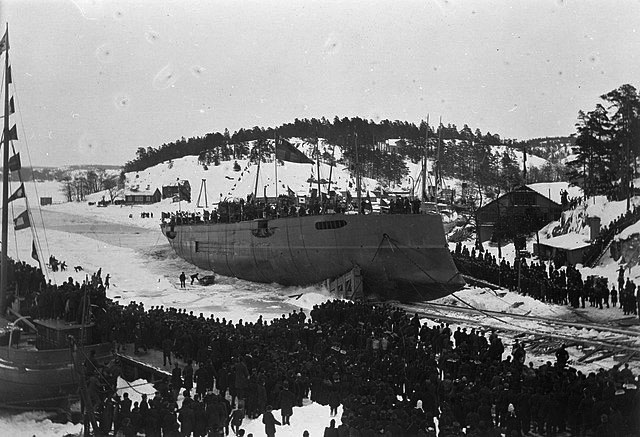
Launch of HMS Thule in winter, 4 March 1893.
HMS Thule was delivered to the navy on 1 December 1893, and served in her role untl 1923, but like her sister found some use afterwards. Until 1928 she was an accommodation ship, and was sold the first to scrap, in 1933. Eventually, the heavily reconstructed lead ship, Svea, outlived both her sister ships.
In 1895, she participate with Göta to the inauguration of the Kiel Canal, taking part in the review and travel of the Canal. In 1899, she was funded for a comprehensive modernization, the second in order. It was done at Karlskrona shipyard. Afterwards, she was transferred from the coastal squadron to the local forces. In 1905 she returned to the forefront of Swedish war planning. In the First World War she took part in neutrality Guard, travalling little due to the age of her machinery. In 1916, she was transferred from the Stockholm squadron to the Gothenburg squadron (west coast). In 1923 she was no longer relevant and it was decided to decommission her. She was rebuilt as an accommodation ship with her armament removed. In 1928 she was decommissioned for good, stricken, but not scrapped right away. Instead, she was modified as a target ship during, moored in the old shipyard area in Karlskrona. Sveral tests were made, nut not enough to sink her. In 1933 she was sold for scrapping, the earliest to go.
Links/Src
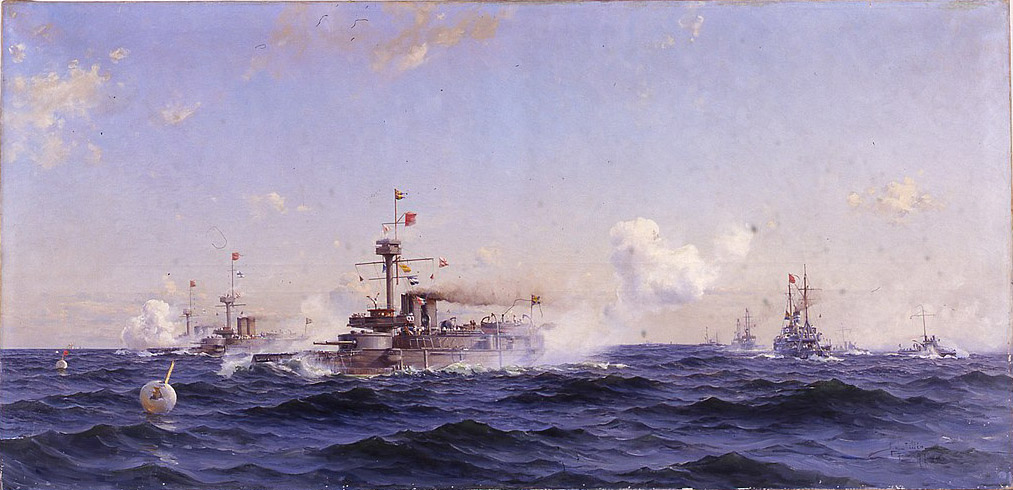
Nice painting showing the three Svea-class “Pansarbatar” at sea (Stockholm History Museum).
Svea on laststandonzombieisland.com
on sv.wikipedia.org
Model kits:
Gota on scalemates

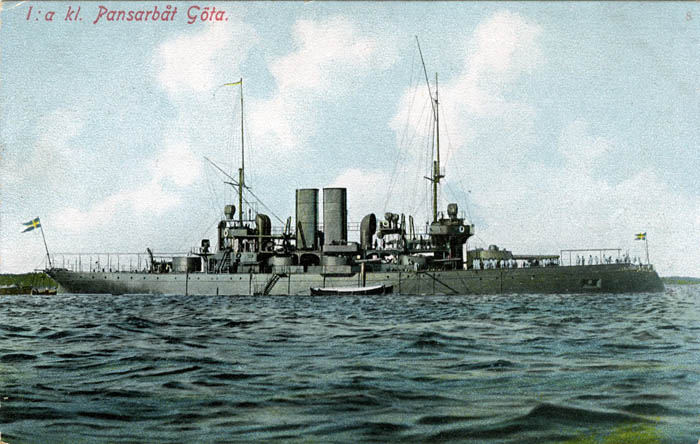
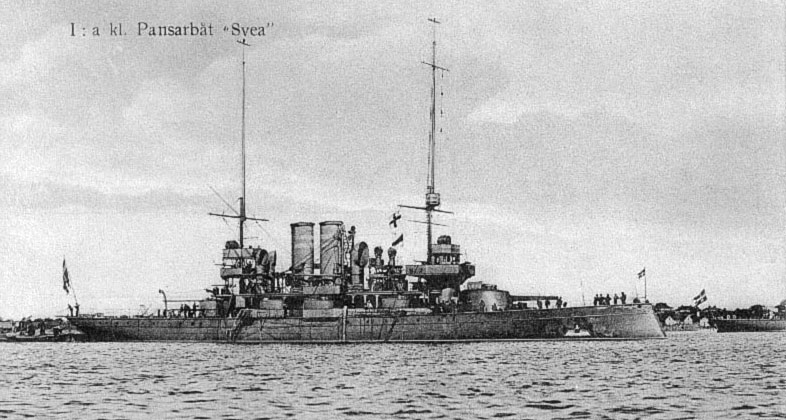
 Latest Facebook Entry -
Latest Facebook Entry -  X(Tweeter) Naval Encyclopedia's deck archive
X(Tweeter) Naval Encyclopedia's deck archive Instagram (@navalencyc)
Instagram (@navalencyc)





 French Navy
French Navy Royal Navy
Royal Navy Russian Navy
Russian Navy Armada Espanola
Armada Espanola Austrian Navy
Austrian Navy K.u.K. Kriegsmarine
K.u.K. Kriegsmarine Dansk Marine
Dansk Marine Nautiko Hellenon
Nautiko Hellenon Koninklije Marine 1870
Koninklije Marine 1870 Marinha do Brasil
Marinha do Brasil Osmanlı Donanması
Osmanlı Donanması Marina Do Peru
Marina Do Peru Marinha do Portugal
Marinha do Portugal Regia Marina 1870
Regia Marina 1870 Nihhon Kaigun 1870
Nihhon Kaigun 1870 Preußische Marine 1870
Preußische Marine 1870 Russkiy Flot 1870
Russkiy Flot 1870 Svenska marinen
Svenska marinen Søværnet
Søværnet Union Navy
Union Navy Confederate Navy
Confederate Navy Armada de Argentina
Armada de Argentina Imperial Chinese Navy
Imperial Chinese Navy Marinha do Portugal
Marinha do Portugal Mexico
Mexico Kaiserliche Marine
Kaiserliche Marine 1898 US Navy
1898 US Navy Sovietskiy Flot
Sovietskiy Flot Royal Canadian Navy
Royal Canadian Navy Royal Australian Navy
Royal Australian Navy RNZN Fleet
RNZN Fleet Chinese Navy 1937
Chinese Navy 1937 Kriegsmarine
Kriegsmarine Chilean Navy
Chilean Navy Danish Navy
Danish Navy Finnish Navy
Finnish Navy Hellenic Navy
Hellenic Navy Polish Navy
Polish Navy Romanian Navy
Romanian Navy Turkish Navy
Turkish Navy Royal Yugoslav Navy
Royal Yugoslav Navy Royal Thai Navy
Royal Thai Navy Minor Navies
Minor Navies Albania
Albania Austria
Austria Belgium
Belgium Columbia
Columbia Costa Rica
Costa Rica Cuba
Cuba Czechoslovakia
Czechoslovakia Dominican Republic
Dominican Republic Haiti
Haiti Hungary
Hungary Honduras
Honduras Estonia
Estonia Iceland
Iceland Eire
Eire Equador
Equador Iran
Iran Iraq
Iraq Latvia
Latvia Liberia
Liberia Lithuania
Lithuania Mandchukuo
Mandchukuo Morocco
Morocco Nicaragua
Nicaragua Persia
Persia San Salvador
San Salvador Sarawak
Sarawak Uruguay
Uruguay Venezuela
Venezuela Zanzibar
Zanzibar Warsaw Pact Navies
Warsaw Pact Navies Bulgaria
Bulgaria Hungary
Hungary

 Bundesmarine
Bundesmarine Dutch Navy
Dutch Navy Hellenic Navy
Hellenic Navy Marina Militare
Marina Militare Yugoslav Navy
Yugoslav Navy Chinese Navy
Chinese Navy Indian Navy
Indian Navy Indonesian Navy
Indonesian Navy JMSDF
JMSDF North Korean Navy
North Korean Navy Pakistani Navy
Pakistani Navy Philippines Navy
Philippines Navy ROKN
ROKN Rep. of Singapore Navy
Rep. of Singapore Navy Taiwanese Navy
Taiwanese Navy IDF Navy
IDF Navy Saudi Navy
Saudi Navy Royal New Zealand Navy
Royal New Zealand Navy Egyptian Navy
Egyptian Navy South African Navy
South African Navy






























 Ukrainian Navy
Ukrainian Navy dbodesign
dbodesign